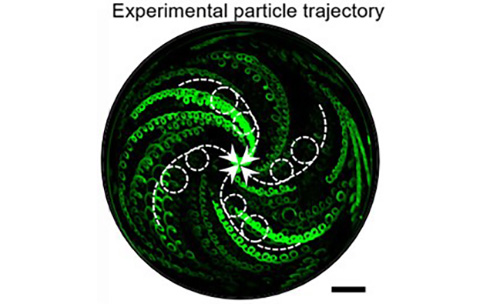
The biological molecule RNA, can be released from the cell and travel throughout the body as extracellular RNA (exRNA) in small containers called extracellular vesicles (EVs). When RNA is outside a cell, it is referred to as extracellular RNA or “exRNA.” RNA, like many biomolecules and organisms, including DNA, proteins, bacteria, and viruses, have sizes that range in the nanoscale or sub micrometer scale. The ability to detect and separate bioparticles like exRNA and their carriers, including EVs, is of great importance in biology, chemistry, and medicine. Acousticfluidics is the fusion of acoustics and microfluidics methods; using sound to create movement in fluids containing tiny particles. However, most acoustic methods focus on manipulating particles larger than 100 nanometers, and systems at the nanoscale, which are even smaller, are sometimes hampered by low sample yields and require long processing periods. Detecting exRNA and how it travels through the body is a focus of The NIH Common Fund Extracellular RNA Communication (ERC) program. In its current stage, the program is developing tools and technologies to provide greater understanding of complexes, called extracellular vesicles (EVs), that carry exRNA through the human body. EVs, and particularly exosomes, which are nanoscale EVs ranging from 30 to 150 nanometers, have emerged as potentially powerful tools for biomedical research, biomarker discovery, disease diagnostics, and health monitoring. ERC researchers Dr. Huang and colleagues are exploring ways that use acousticfluidics to achieve isolation of different EV subpopulations.
Now, these ERC program researchers have developed an acoustofluidic centrifuge system that uses acoustically driven spinning liquid droplets to separate bioparticles with sizes down to a few nanometers that are suspended within the droplets. The system optimizes different acoustic parameters (e.g., frequency and amplitude) and droplet proportions to generate different particle paths for different-sized particles within the same sample droplet. The researchers found that particles within the spinning droplet are rapidly concentrated to the center of the droplet. Similar nanoparticles cluster together separate from other sized particles. Most excitingly, the system enables particles as small as 28 nanometers, as well as strands of DNA, to be concentrated within 1 minute. Future optimization will need to account for the low sample volume commonly found in exRNA research. However, the development of this platform and technology paves the way for substantially simplifying and speeding up sample processing and detection for various applications, like point-of-care diagnostics and liquid biopsies.
Reference:
In the News:
Acoustofluidic centrifuge for nanoparticle enrichment and assortment (link is external)


